Analysis of Research Papers
VerifiedAdded on 2023/03/17
|11
|2917
|82
AI Summary
This document provides an analysis of research papers on various topics such as mining disasters, environmental footprint, corporate accountability, corporate governance, and corporate social responsibility. The papers discuss the causes and prevention of mining disasters, the environmental impact of copper mining, the accountability of multinational corporations for disasters, the relationship between environmental reporting and corporate governance, and the regulation of corporate social responsibility. The research papers provide valuable insights into these important topics.
Contribute Materials
Your contribution can guide someone’s learning journey. Share your
documents today.

Running Head: Analysis of Research Papers 1
Analysis of Research Papers
Name
Affiliated Institute
Date
Analysis of Research Papers
Name
Affiliated Institute
Date
Secure Best Marks with AI Grader
Need help grading? Try our AI Grader for instant feedback on your assignments.

Analysis of Research Papers 2
Case of Trailing Storage
The main issue looked at in this paper is to determine whether safe mining can be
practised to protect the local population from environmental disasters as a result of mining,
which has been described as an unavoidable activity. Most of the mining disasters have been
caused by the failure of trailing storage facilities, which are mainly made up of mining waste.
Environmental disruptions cannot be avoided, but we can prevent environmental disasters caused
by mining activities by handling the trailing facilities.
The main problem to the proper handling of the trailing facilities is political due to the
high expenses incurred while following the correct procedures. The author affirms that unless
companies are held to a higher standard of handling the trailing facilities, accidents will continue
to occur. Trailing waste is usually held in dams constructed of mining wastes (Townsend and
Townsend, 2004).
Qualitative research was carried out on both the publish and unpublished data concerning
three dams; The Ok Tedi mine, Mount Polly mine, and McLaughlin mine. Only the McLaughlin
mine was a success in terms of managing the integrity of their trailing storage while the Ok Tedi
and Polly mines have been faced with environmental disasters. On the Ok Tedi mine which
dealt with copper and gold pits, they prepared an environmental report where they stated to have
spent only $220,000 on the environmental impact of the mine which is significantly small and
consequently limiting its effect. The McLaughlin mine ran during the same period as the Ok
Tedi mine, but the difference is that their trailing storage was maintained correctly that it is today
used as a natural reserve with zero toxic waste detected in the water (Walker, 2009). The success
has been attributed to a mix of regulatory exigency, management style, and coming together of
like-minded individuals to handle the situation.
Case of Trailing Storage
The main issue looked at in this paper is to determine whether safe mining can be
practised to protect the local population from environmental disasters as a result of mining,
which has been described as an unavoidable activity. Most of the mining disasters have been
caused by the failure of trailing storage facilities, which are mainly made up of mining waste.
Environmental disruptions cannot be avoided, but we can prevent environmental disasters caused
by mining activities by handling the trailing facilities.
The main problem to the proper handling of the trailing facilities is political due to the
high expenses incurred while following the correct procedures. The author affirms that unless
companies are held to a higher standard of handling the trailing facilities, accidents will continue
to occur. Trailing waste is usually held in dams constructed of mining wastes (Townsend and
Townsend, 2004).
Qualitative research was carried out on both the publish and unpublished data concerning
three dams; The Ok Tedi mine, Mount Polly mine, and McLaughlin mine. Only the McLaughlin
mine was a success in terms of managing the integrity of their trailing storage while the Ok Tedi
and Polly mines have been faced with environmental disasters. On the Ok Tedi mine which
dealt with copper and gold pits, they prepared an environmental report where they stated to have
spent only $220,000 on the environmental impact of the mine which is significantly small and
consequently limiting its effect. The McLaughlin mine ran during the same period as the Ok
Tedi mine, but the difference is that their trailing storage was maintained correctly that it is today
used as a natural reserve with zero toxic waste detected in the water (Walker, 2009). The success
has been attributed to a mix of regulatory exigency, management style, and coming together of
like-minded individuals to handle the situation.
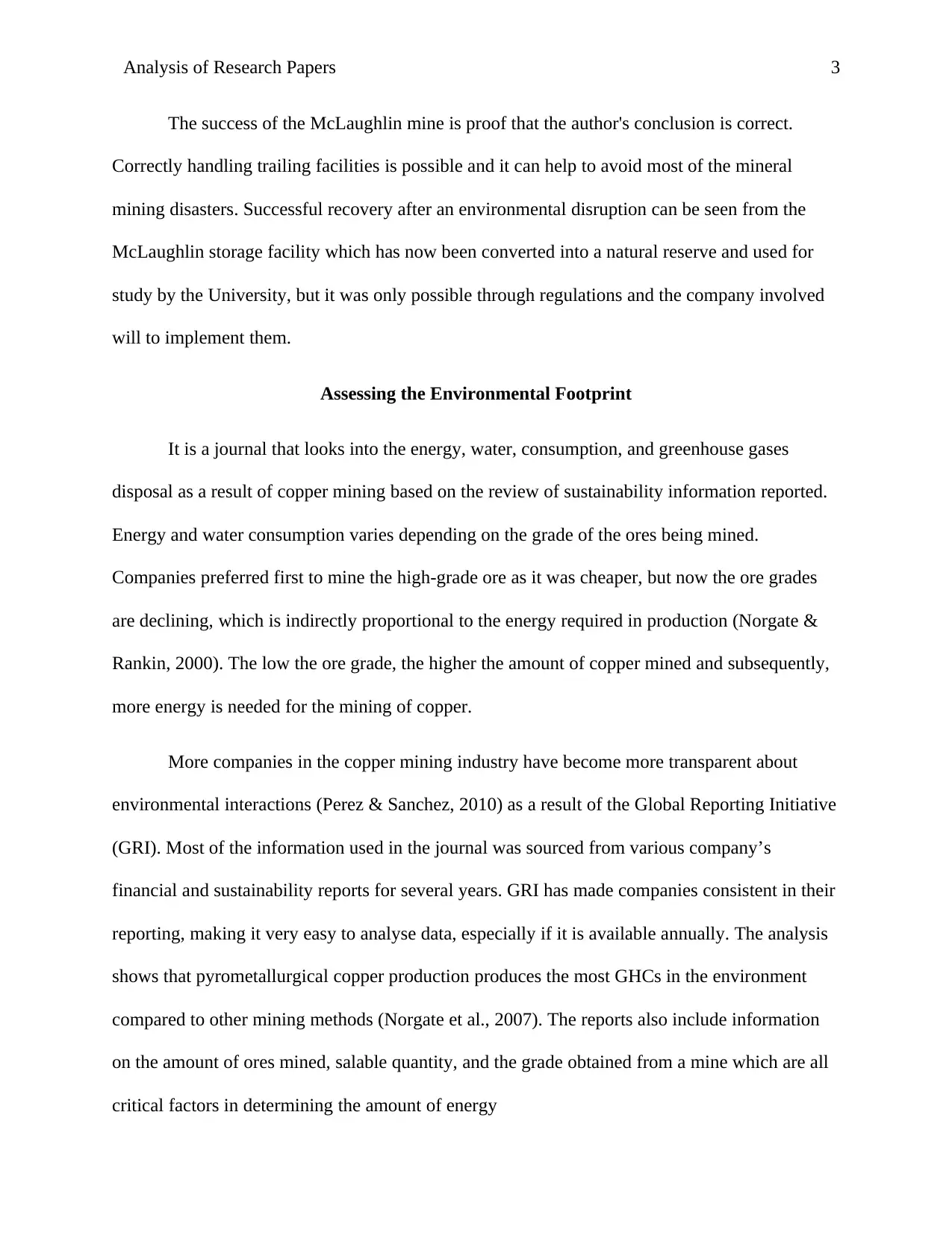
Analysis of Research Papers 3
The success of the McLaughlin mine is proof that the author's conclusion is correct.
Correctly handling trailing facilities is possible and it can help to avoid most of the mineral
mining disasters. Successful recovery after an environmental disruption can be seen from the
McLaughlin storage facility which has now been converted into a natural reserve and used for
study by the University, but it was only possible through regulations and the company involved
will to implement them.
Assessing the Environmental Footprint
It is a journal that looks into the energy, water, consumption, and greenhouse gases
disposal as a result of copper mining based on the review of sustainability information reported.
Energy and water consumption varies depending on the grade of the ores being mined.
Companies preferred first to mine the high-grade ore as it was cheaper, but now the ore grades
are declining, which is indirectly proportional to the energy required in production (Norgate &
Rankin, 2000). The low the ore grade, the higher the amount of copper mined and subsequently,
more energy is needed for the mining of copper.
More companies in the copper mining industry have become more transparent about
environmental interactions (Perez & Sanchez, 2010) as a result of the Global Reporting Initiative
(GRI). Most of the information used in the journal was sourced from various company’s
financial and sustainability reports for several years. GRI has made companies consistent in their
reporting, making it very easy to analyse data, especially if it is available annually. The analysis
shows that pyrometallurgical copper production produces the most GHCs in the environment
compared to other mining methods (Norgate et al., 2007). The reports also include information
on the amount of ores mined, salable quantity, and the grade obtained from a mine which are all
critical factors in determining the amount of energy
The success of the McLaughlin mine is proof that the author's conclusion is correct.
Correctly handling trailing facilities is possible and it can help to avoid most of the mineral
mining disasters. Successful recovery after an environmental disruption can be seen from the
McLaughlin storage facility which has now been converted into a natural reserve and used for
study by the University, but it was only possible through regulations and the company involved
will to implement them.
Assessing the Environmental Footprint
It is a journal that looks into the energy, water, consumption, and greenhouse gases
disposal as a result of copper mining based on the review of sustainability information reported.
Energy and water consumption varies depending on the grade of the ores being mined.
Companies preferred first to mine the high-grade ore as it was cheaper, but now the ore grades
are declining, which is indirectly proportional to the energy required in production (Norgate &
Rankin, 2000). The low the ore grade, the higher the amount of copper mined and subsequently,
more energy is needed for the mining of copper.
More companies in the copper mining industry have become more transparent about
environmental interactions (Perez & Sanchez, 2010) as a result of the Global Reporting Initiative
(GRI). Most of the information used in the journal was sourced from various company’s
financial and sustainability reports for several years. GRI has made companies consistent in their
reporting, making it very easy to analyse data, especially if it is available annually. The analysis
shows that pyrometallurgical copper production produces the most GHCs in the environment
compared to other mining methods (Norgate et al., 2007). The reports also include information
on the amount of ores mined, salable quantity, and the grade obtained from a mine which are all
critical factors in determining the amount of energy
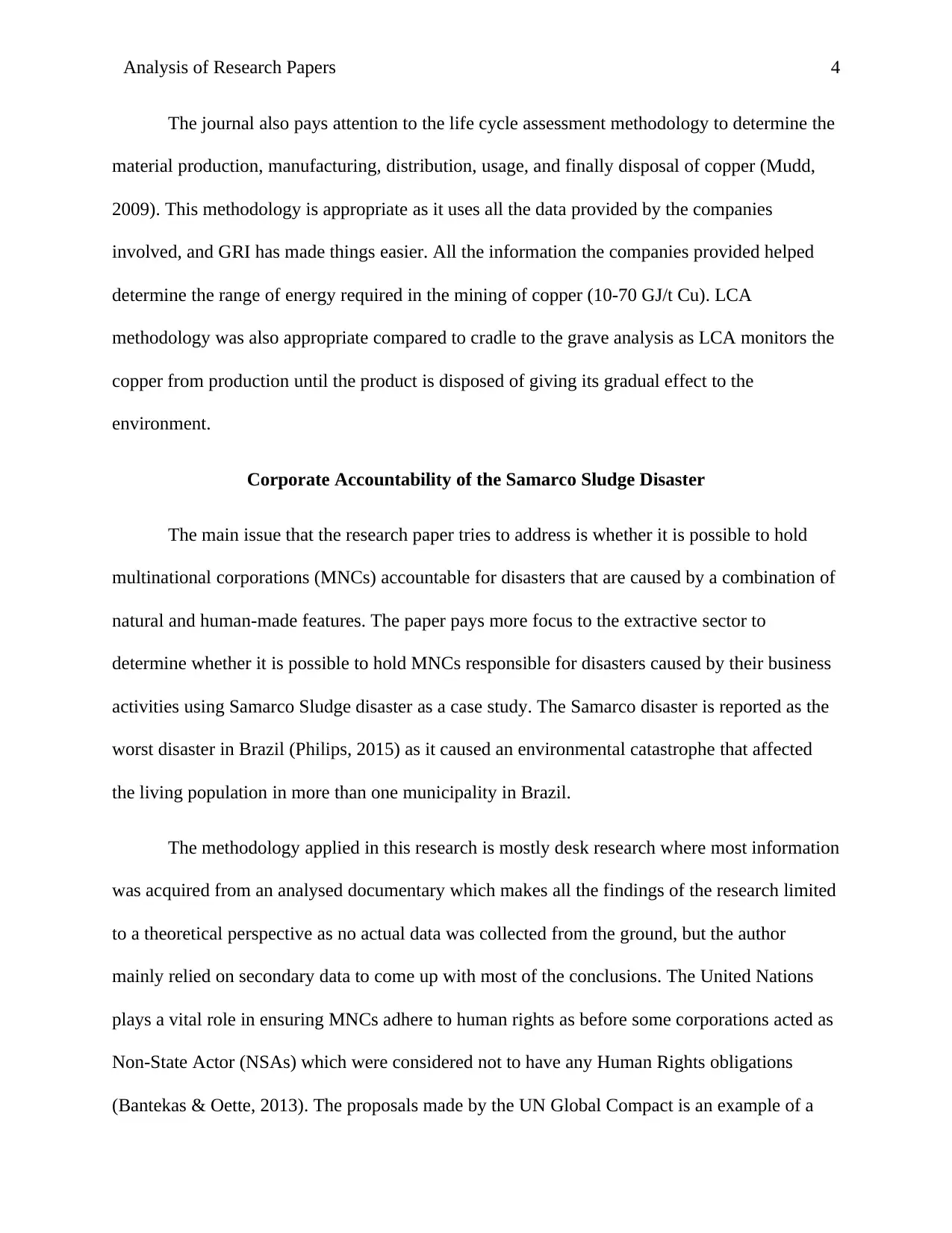
Analysis of Research Papers 4
The journal also pays attention to the life cycle assessment methodology to determine the
material production, manufacturing, distribution, usage, and finally disposal of copper (Mudd,
2009). This methodology is appropriate as it uses all the data provided by the companies
involved, and GRI has made things easier. All the information the companies provided helped
determine the range of energy required in the mining of copper (10-70 GJ/t Cu). LCA
methodology was also appropriate compared to cradle to the grave analysis as LCA monitors the
copper from production until the product is disposed of giving its gradual effect to the
environment.
Corporate Accountability of the Samarco Sludge Disaster
The main issue that the research paper tries to address is whether it is possible to hold
multinational corporations (MNCs) accountable for disasters that are caused by a combination of
natural and human-made features. The paper pays more focus to the extractive sector to
determine whether it is possible to hold MNCs responsible for disasters caused by their business
activities using Samarco Sludge disaster as a case study. The Samarco disaster is reported as the
worst disaster in Brazil (Philips, 2015) as it caused an environmental catastrophe that affected
the living population in more than one municipality in Brazil.
The methodology applied in this research is mostly desk research where most information
was acquired from an analysed documentary which makes all the findings of the research limited
to a theoretical perspective as no actual data was collected from the ground, but the author
mainly relied on secondary data to come up with most of the conclusions. The United Nations
plays a vital role in ensuring MNCs adhere to human rights as before some corporations acted as
Non-State Actor (NSAs) which were considered not to have any Human Rights obligations
(Bantekas & Oette, 2013). The proposals made by the UN Global Compact is an example of a
The journal also pays attention to the life cycle assessment methodology to determine the
material production, manufacturing, distribution, usage, and finally disposal of copper (Mudd,
2009). This methodology is appropriate as it uses all the data provided by the companies
involved, and GRI has made things easier. All the information the companies provided helped
determine the range of energy required in the mining of copper (10-70 GJ/t Cu). LCA
methodology was also appropriate compared to cradle to the grave analysis as LCA monitors the
copper from production until the product is disposed of giving its gradual effect to the
environment.
Corporate Accountability of the Samarco Sludge Disaster
The main issue that the research paper tries to address is whether it is possible to hold
multinational corporations (MNCs) accountable for disasters that are caused by a combination of
natural and human-made features. The paper pays more focus to the extractive sector to
determine whether it is possible to hold MNCs responsible for disasters caused by their business
activities using Samarco Sludge disaster as a case study. The Samarco disaster is reported as the
worst disaster in Brazil (Philips, 2015) as it caused an environmental catastrophe that affected
the living population in more than one municipality in Brazil.
The methodology applied in this research is mostly desk research where most information
was acquired from an analysed documentary which makes all the findings of the research limited
to a theoretical perspective as no actual data was collected from the ground, but the author
mainly relied on secondary data to come up with most of the conclusions. The United Nations
plays a vital role in ensuring MNCs adhere to human rights as before some corporations acted as
Non-State Actor (NSAs) which were considered not to have any Human Rights obligations
(Bantekas & Oette, 2013). The proposals made by the UN Global Compact is an example of a
Secure Best Marks with AI Grader
Need help grading? Try our AI Grader for instant feedback on your assignments.
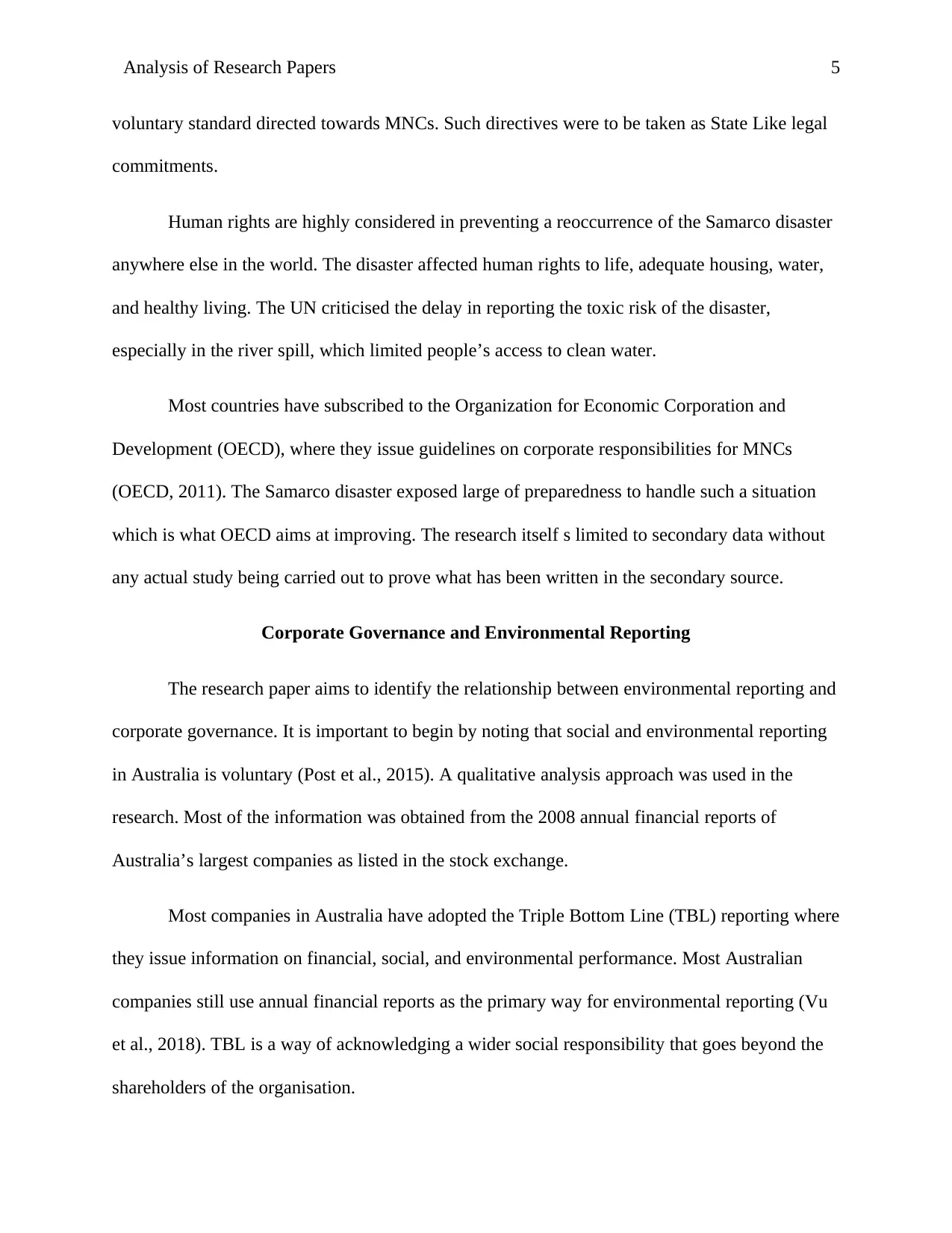
Analysis of Research Papers 5
voluntary standard directed towards MNCs. Such directives were to be taken as State Like legal
commitments.
Human rights are highly considered in preventing a reoccurrence of the Samarco disaster
anywhere else in the world. The disaster affected human rights to life, adequate housing, water,
and healthy living. The UN criticised the delay in reporting the toxic risk of the disaster,
especially in the river spill, which limited people’s access to clean water.
Most countries have subscribed to the Organization for Economic Corporation and
Development (OECD), where they issue guidelines on corporate responsibilities for MNCs
(OECD, 2011). The Samarco disaster exposed large of preparedness to handle such a situation
which is what OECD aims at improving. The research itself s limited to secondary data without
any actual study being carried out to prove what has been written in the secondary source.
Corporate Governance and Environmental Reporting
The research paper aims to identify the relationship between environmental reporting and
corporate governance. It is important to begin by noting that social and environmental reporting
in Australia is voluntary (Post et al., 2015). A qualitative analysis approach was used in the
research. Most of the information was obtained from the 2008 annual financial reports of
Australia’s largest companies as listed in the stock exchange.
Most companies in Australia have adopted the Triple Bottom Line (TBL) reporting where
they issue information on financial, social, and environmental performance. Most Australian
companies still use annual financial reports as the primary way for environmental reporting (Vu
et al., 2018). TBL is a way of acknowledging a wider social responsibility that goes beyond the
shareholders of the organisation.
voluntary standard directed towards MNCs. Such directives were to be taken as State Like legal
commitments.
Human rights are highly considered in preventing a reoccurrence of the Samarco disaster
anywhere else in the world. The disaster affected human rights to life, adequate housing, water,
and healthy living. The UN criticised the delay in reporting the toxic risk of the disaster,
especially in the river spill, which limited people’s access to clean water.
Most countries have subscribed to the Organization for Economic Corporation and
Development (OECD), where they issue guidelines on corporate responsibilities for MNCs
(OECD, 2011). The Samarco disaster exposed large of preparedness to handle such a situation
which is what OECD aims at improving. The research itself s limited to secondary data without
any actual study being carried out to prove what has been written in the secondary source.
Corporate Governance and Environmental Reporting
The research paper aims to identify the relationship between environmental reporting and
corporate governance. It is important to begin by noting that social and environmental reporting
in Australia is voluntary (Post et al., 2015). A qualitative analysis approach was used in the
research. Most of the information was obtained from the 2008 annual financial reports of
Australia’s largest companies as listed in the stock exchange.
Most companies in Australia have adopted the Triple Bottom Line (TBL) reporting where
they issue information on financial, social, and environmental performance. Most Australian
companies still use annual financial reports as the primary way for environmental reporting (Vu
et al., 2018). TBL is a way of acknowledging a wider social responsibility that goes beyond the
shareholders of the organisation.
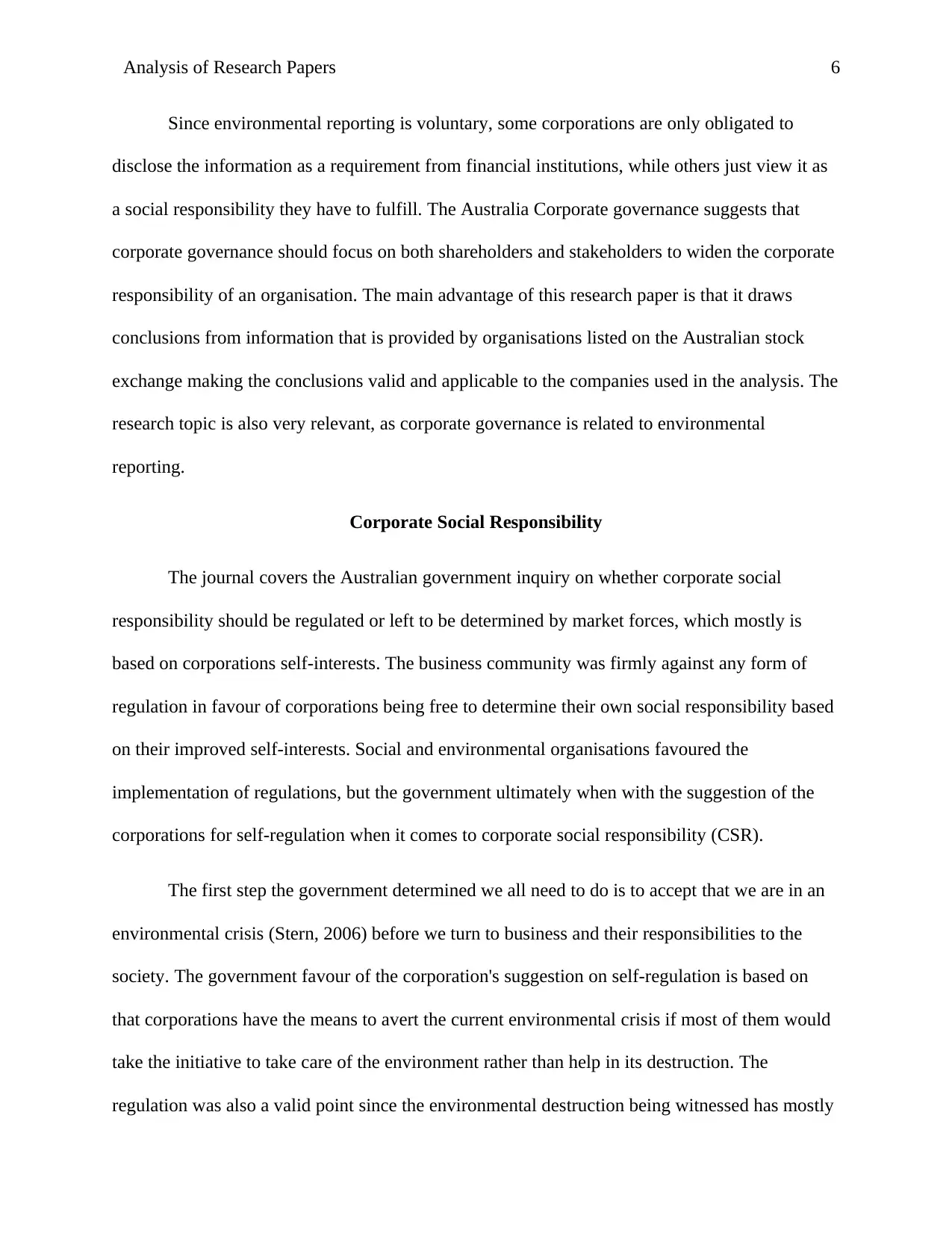
Analysis of Research Papers 6
Since environmental reporting is voluntary, some corporations are only obligated to
disclose the information as a requirement from financial institutions, while others just view it as
a social responsibility they have to fulfill. The Australia Corporate governance suggests that
corporate governance should focus on both shareholders and stakeholders to widen the corporate
responsibility of an organisation. The main advantage of this research paper is that it draws
conclusions from information that is provided by organisations listed on the Australian stock
exchange making the conclusions valid and applicable to the companies used in the analysis. The
research topic is also very relevant, as corporate governance is related to environmental
reporting.
Corporate Social Responsibility
The journal covers the Australian government inquiry on whether corporate social
responsibility should be regulated or left to be determined by market forces, which mostly is
based on corporations self-interests. The business community was firmly against any form of
regulation in favour of corporations being free to determine their own social responsibility based
on their improved self-interests. Social and environmental organisations favoured the
implementation of regulations, but the government ultimately when with the suggestion of the
corporations for self-regulation when it comes to corporate social responsibility (CSR).
The first step the government determined we all need to do is to accept that we are in an
environmental crisis (Stern, 2006) before we turn to business and their responsibilities to the
society. The government favour of the corporation's suggestion on self-regulation is based on
that corporations have the means to avert the current environmental crisis if most of them would
take the initiative to take care of the environment rather than help in its destruction. The
regulation was also a valid point since the environmental destruction being witnessed has mostly
Since environmental reporting is voluntary, some corporations are only obligated to
disclose the information as a requirement from financial institutions, while others just view it as
a social responsibility they have to fulfill. The Australia Corporate governance suggests that
corporate governance should focus on both shareholders and stakeholders to widen the corporate
responsibility of an organisation. The main advantage of this research paper is that it draws
conclusions from information that is provided by organisations listed on the Australian stock
exchange making the conclusions valid and applicable to the companies used in the analysis. The
research topic is also very relevant, as corporate governance is related to environmental
reporting.
Corporate Social Responsibility
The journal covers the Australian government inquiry on whether corporate social
responsibility should be regulated or left to be determined by market forces, which mostly is
based on corporations self-interests. The business community was firmly against any form of
regulation in favour of corporations being free to determine their own social responsibility based
on their improved self-interests. Social and environmental organisations favoured the
implementation of regulations, but the government ultimately when with the suggestion of the
corporations for self-regulation when it comes to corporate social responsibility (CSR).
The first step the government determined we all need to do is to accept that we are in an
environmental crisis (Stern, 2006) before we turn to business and their responsibilities to the
society. The government favour of the corporation's suggestion on self-regulation is based on
that corporations have the means to avert the current environmental crisis if most of them would
take the initiative to take care of the environment rather than help in its destruction. The
regulation was also a valid point since the environmental destruction being witnessed has mostly
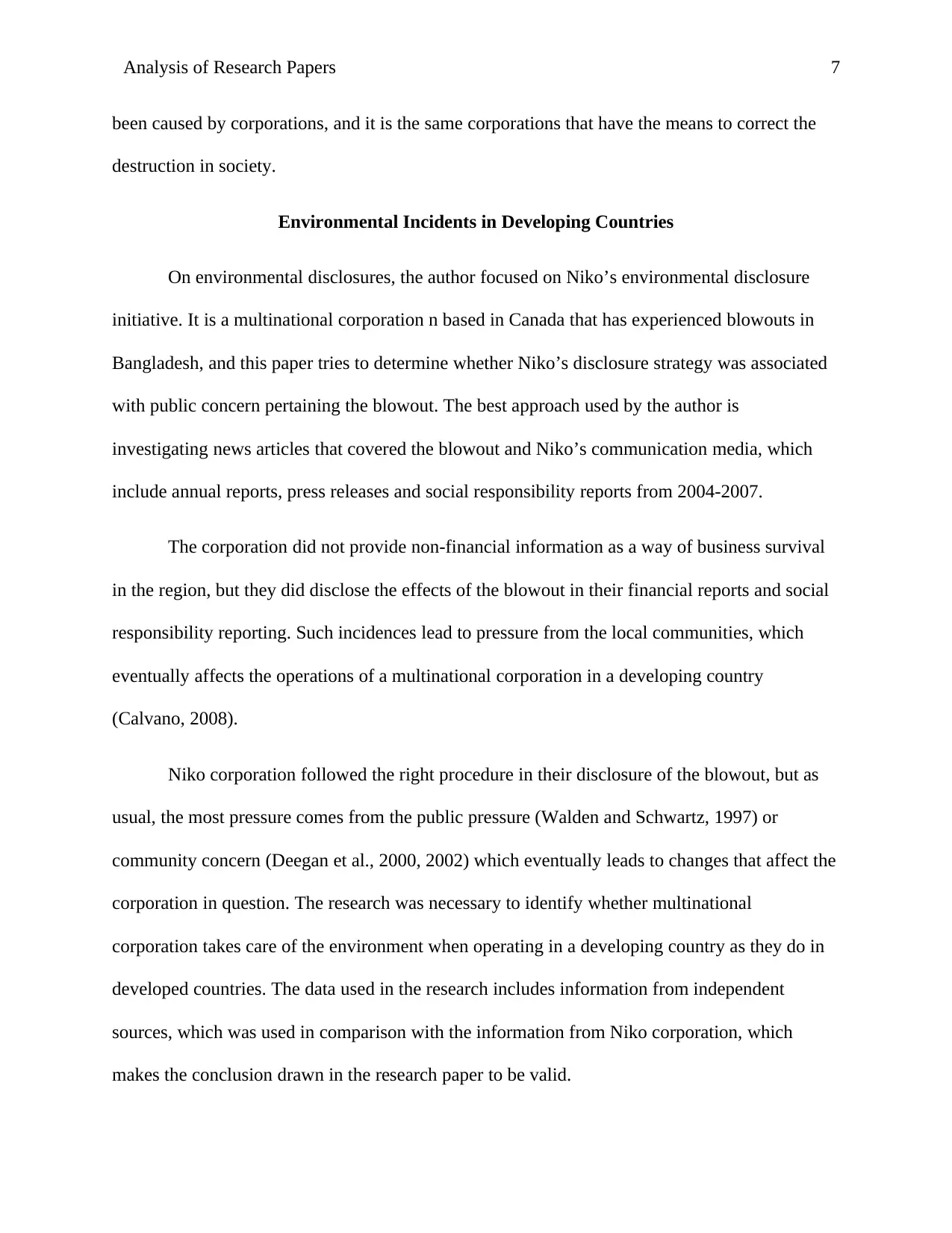
Analysis of Research Papers 7
been caused by corporations, and it is the same corporations that have the means to correct the
destruction in society.
Environmental Incidents in Developing Countries
On environmental disclosures, the author focused on Niko’s environmental disclosure
initiative. It is a multinational corporation n based in Canada that has experienced blowouts in
Bangladesh, and this paper tries to determine whether Niko’s disclosure strategy was associated
with public concern pertaining the blowout. The best approach used by the author is
investigating news articles that covered the blowout and Niko’s communication media, which
include annual reports, press releases and social responsibility reports from 2004-2007.
The corporation did not provide non-financial information as a way of business survival
in the region, but they did disclose the effects of the blowout in their financial reports and social
responsibility reporting. Such incidences lead to pressure from the local communities, which
eventually affects the operations of a multinational corporation in a developing country
(Calvano, 2008).
Niko corporation followed the right procedure in their disclosure of the blowout, but as
usual, the most pressure comes from the public pressure (Walden and Schwartz, 1997) or
community concern (Deegan et al., 2000, 2002) which eventually leads to changes that affect the
corporation in question. The research was necessary to identify whether multinational
corporation takes care of the environment when operating in a developing country as they do in
developed countries. The data used in the research includes information from independent
sources, which was used in comparison with the information from Niko corporation, which
makes the conclusion drawn in the research paper to be valid.
been caused by corporations, and it is the same corporations that have the means to correct the
destruction in society.
Environmental Incidents in Developing Countries
On environmental disclosures, the author focused on Niko’s environmental disclosure
initiative. It is a multinational corporation n based in Canada that has experienced blowouts in
Bangladesh, and this paper tries to determine whether Niko’s disclosure strategy was associated
with public concern pertaining the blowout. The best approach used by the author is
investigating news articles that covered the blowout and Niko’s communication media, which
include annual reports, press releases and social responsibility reports from 2004-2007.
The corporation did not provide non-financial information as a way of business survival
in the region, but they did disclose the effects of the blowout in their financial reports and social
responsibility reporting. Such incidences lead to pressure from the local communities, which
eventually affects the operations of a multinational corporation in a developing country
(Calvano, 2008).
Niko corporation followed the right procedure in their disclosure of the blowout, but as
usual, the most pressure comes from the public pressure (Walden and Schwartz, 1997) or
community concern (Deegan et al., 2000, 2002) which eventually leads to changes that affect the
corporation in question. The research was necessary to identify whether multinational
corporation takes care of the environment when operating in a developing country as they do in
developed countries. The data used in the research includes information from independent
sources, which was used in comparison with the information from Niko corporation, which
makes the conclusion drawn in the research paper to be valid.
Paraphrase This Document
Need a fresh take? Get an instant paraphrase of this document with our AI Paraphraser

Analysis of Research Papers 8
The Sustainability Report of Rio Tinto
The sustainability report pays more focus on safe business practices to avoid accidents
and incidents that have previously been experienced in the organisation. They have a strong code
of conduct that is focused on teamwork, safety, respect, integrity and excellence. It is a
multinational corporation that identifies the need to foster good working relationships with the
host governments and local residents. They also aim to foster good working relationships in the
industry through the formation of associations with the same goals.
The report also highlights some of the tragedies that the company faced during the 2017
operations. An employee died while on an exploration mission, and it has been reported in the
report with investigations being carried out to prevent an occurrence of such an incident again.
The company also pays attention to better water and trailing management for environmental
benefits. Good trailing management ensures that disrupted land can one day be used for other
purposes.
Rio Tinto’s Sustainability in overseas countries revolves around safety, security,
environmental management, and achieving compliance with the group’s responsibility and
commitments. Equal focus is paid to how the corporation works in foreign countries as well as
the tonnes of minerals they mine across the world. For the 2017 report, the corporation claims a
5% improvement in the occurrence of accidents. The products mined and processed by the
company help to improve the lives of people across the world but that does not give the
corporation a justification of not ensuring that they help to protect the environment anywhere
they carry out mining activities. Improvements can still be mad on the sustainability initiative to
reduce the number of accidents and provide more insurance cover to the employees.
The Sustainability Report of Rio Tinto
The sustainability report pays more focus on safe business practices to avoid accidents
and incidents that have previously been experienced in the organisation. They have a strong code
of conduct that is focused on teamwork, safety, respect, integrity and excellence. It is a
multinational corporation that identifies the need to foster good working relationships with the
host governments and local residents. They also aim to foster good working relationships in the
industry through the formation of associations with the same goals.
The report also highlights some of the tragedies that the company faced during the 2017
operations. An employee died while on an exploration mission, and it has been reported in the
report with investigations being carried out to prevent an occurrence of such an incident again.
The company also pays attention to better water and trailing management for environmental
benefits. Good trailing management ensures that disrupted land can one day be used for other
purposes.
Rio Tinto’s Sustainability in overseas countries revolves around safety, security,
environmental management, and achieving compliance with the group’s responsibility and
commitments. Equal focus is paid to how the corporation works in foreign countries as well as
the tonnes of minerals they mine across the world. For the 2017 report, the corporation claims a
5% improvement in the occurrence of accidents. The products mined and processed by the
company help to improve the lives of people across the world but that does not give the
corporation a justification of not ensuring that they help to protect the environment anywhere
they carry out mining activities. Improvements can still be mad on the sustainability initiative to
reduce the number of accidents and provide more insurance cover to the employees.
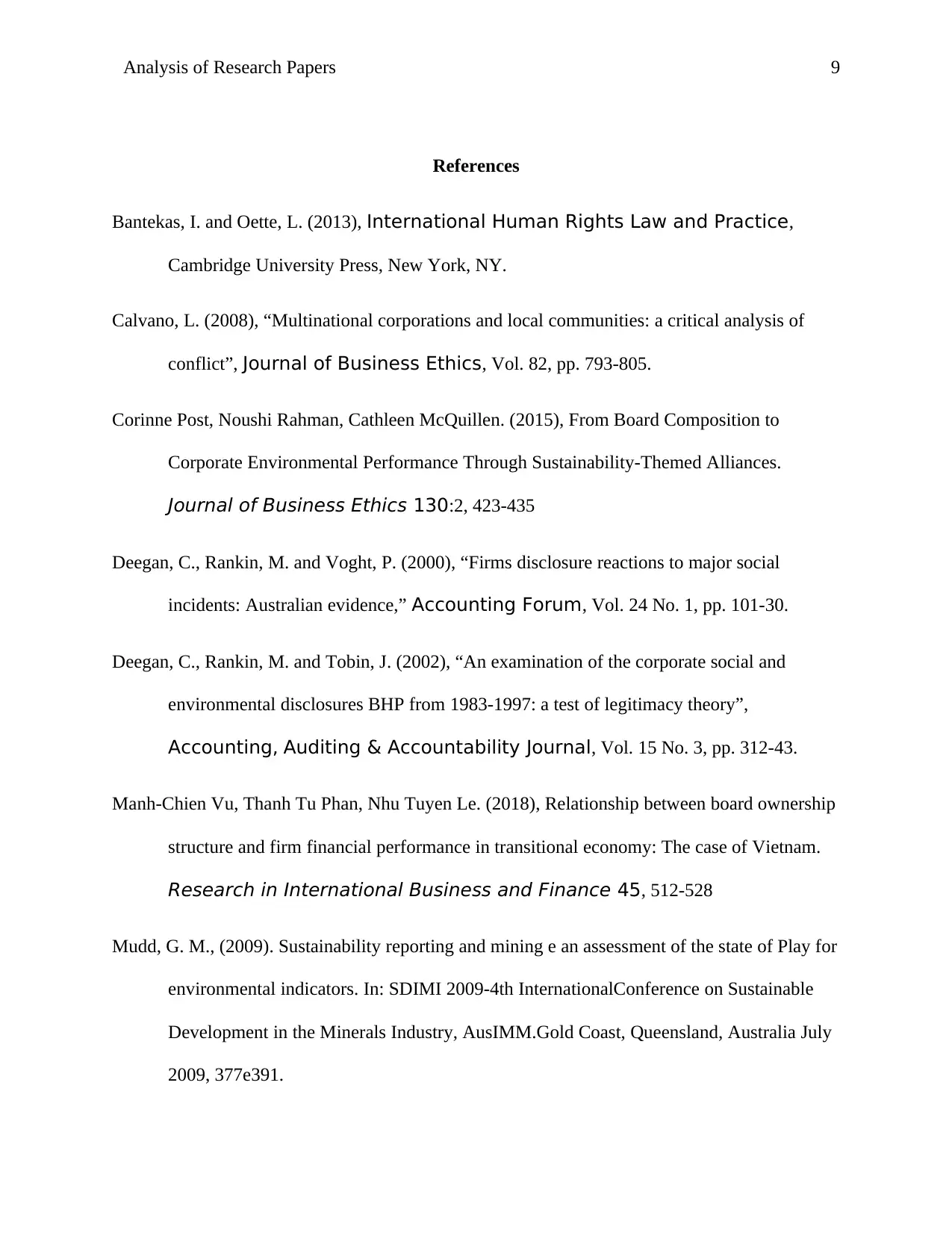
Analysis of Research Papers 9
References
Bantekas, I. and Oette, L. (2013), International Human Rights Law and Practice,
Cambridge University Press, New York, NY.
Calvano, L. (2008), “Multinational corporations and local communities: a critical analysis of
conflict”, Journal of Business Ethics, Vol. 82, pp. 793-805.
Corinne Post, Noushi Rahman, Cathleen McQuillen. (2015), From Board Composition to
Corporate Environmental Performance Through Sustainability-Themed Alliances.
Journal of Business Ethics 130:2, 423-435
Deegan, C., Rankin, M. and Voght, P. (2000), “Firms disclosure reactions to major social
incidents: Australian evidence,” Accounting Forum, Vol. 24 No. 1, pp. 101-30.
Deegan, C., Rankin, M. and Tobin, J. (2002), “An examination of the corporate social and
environmental disclosures BHP from 1983-1997: a test of legitimacy theory”,
Accounting, Auditing & Accountability Journal, Vol. 15 No. 3, pp. 312-43.
Manh-Chien Vu, Thanh Tu Phan, Nhu Tuyen Le. (2018), Relationship between board ownership
structure and firm financial performance in transitional economy: The case of Vietnam.
Research in International Business and Finance 45, 512-528
Mudd, G. M., (2009). Sustainability reporting and mining e an assessment of the state of Play for
environmental indicators. In: SDIMI 2009-4th InternationalConference on Sustainable
Development in the Minerals Industry, AusIMM.Gold Coast, Queensland, Australia July
2009, 377e391.
References
Bantekas, I. and Oette, L. (2013), International Human Rights Law and Practice,
Cambridge University Press, New York, NY.
Calvano, L. (2008), “Multinational corporations and local communities: a critical analysis of
conflict”, Journal of Business Ethics, Vol. 82, pp. 793-805.
Corinne Post, Noushi Rahman, Cathleen McQuillen. (2015), From Board Composition to
Corporate Environmental Performance Through Sustainability-Themed Alliances.
Journal of Business Ethics 130:2, 423-435
Deegan, C., Rankin, M. and Voght, P. (2000), “Firms disclosure reactions to major social
incidents: Australian evidence,” Accounting Forum, Vol. 24 No. 1, pp. 101-30.
Deegan, C., Rankin, M. and Tobin, J. (2002), “An examination of the corporate social and
environmental disclosures BHP from 1983-1997: a test of legitimacy theory”,
Accounting, Auditing & Accountability Journal, Vol. 15 No. 3, pp. 312-43.
Manh-Chien Vu, Thanh Tu Phan, Nhu Tuyen Le. (2018), Relationship between board ownership
structure and firm financial performance in transitional economy: The case of Vietnam.
Research in International Business and Finance 45, 512-528
Mudd, G. M., (2009). Sustainability reporting and mining e an assessment of the state of Play for
environmental indicators. In: SDIMI 2009-4th InternationalConference on Sustainable
Development in the Minerals Industry, AusIMM.Gold Coast, Queensland, Australia July
2009, 377e391.
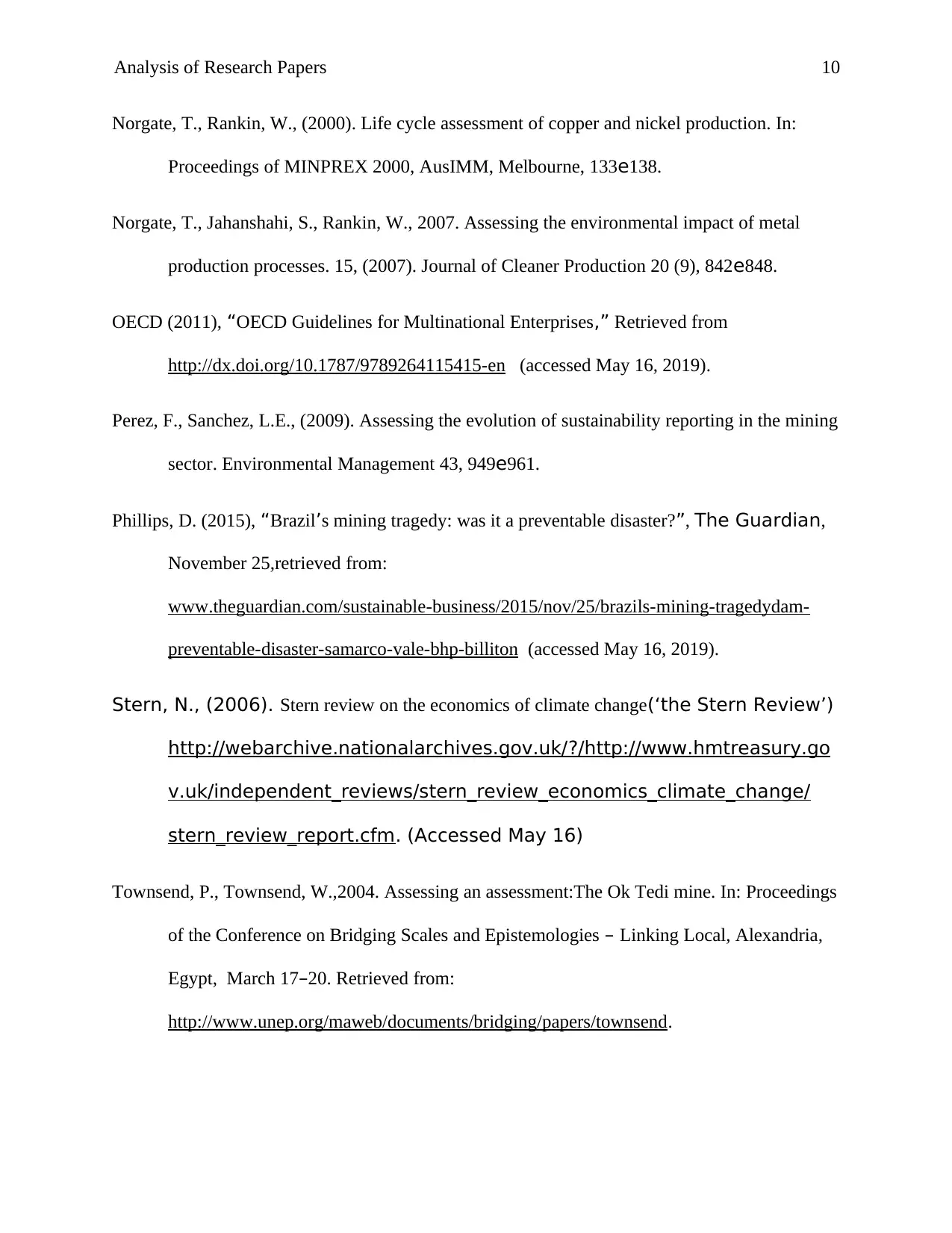
Analysis of Research Papers 10
Norgate, T., Rankin, W., (2000). Life cycle assessment of copper and nickel production. In:
Proceedings of MINPREX 2000, AusIMM, Melbourne, 133e138.
Norgate, T., Jahanshahi, S., Rankin, W., 2007. Assessing the environmental impact of metal
production processes. 15, (2007). Journal of Cleaner Production 20 (9), 842e848.
OECD (2011), “OECD Guidelines for Multinational Enterprises,” Retrieved from
http://dx.doi.org/10.1787/9789264115415-en (accessed May 16, 2019).
Perez, F., Sanchez, L.E., (2009). Assessing the evolution of sustainability reporting in the mining
sector. Environmental Management 43, 949e961.
Phillips, D. (2015), “Brazil’s mining tragedy: was it a preventable disaster?”, The Guardian,
November 25,retrieved from:
www.theguardian.com/sustainable-business/2015/nov/25/brazils-mining-tragedydam-
preventable-disaster-samarco-vale-bhp-billiton (accessed May 16, 2019).
Stern, N., (2006). Stern review on the economics of climate change(‘the Stern Review’)
http://webarchive.nationalarchives.gov.uk/?/http://www.hmtreasury.go
v.uk/independent_reviews/stern_review_economics_climate_change/
stern_review_report.cfm. (Accessed May 16)
Townsend, P., Townsend, W.,2004. Assessing an assessment:The Ok Tedi mine. In: Proceedings
of the Conference on Bridging Scales and Epistemologies – Linking Local, Alexandria,
Egypt, March 17–20. Retrieved from:
http://www.unep.org/maweb/documents/bridging/papers/townsend.
Norgate, T., Rankin, W., (2000). Life cycle assessment of copper and nickel production. In:
Proceedings of MINPREX 2000, AusIMM, Melbourne, 133e138.
Norgate, T., Jahanshahi, S., Rankin, W., 2007. Assessing the environmental impact of metal
production processes. 15, (2007). Journal of Cleaner Production 20 (9), 842e848.
OECD (2011), “OECD Guidelines for Multinational Enterprises,” Retrieved from
http://dx.doi.org/10.1787/9789264115415-en (accessed May 16, 2019).
Perez, F., Sanchez, L.E., (2009). Assessing the evolution of sustainability reporting in the mining
sector. Environmental Management 43, 949e961.
Phillips, D. (2015), “Brazil’s mining tragedy: was it a preventable disaster?”, The Guardian,
November 25,retrieved from:
www.theguardian.com/sustainable-business/2015/nov/25/brazils-mining-tragedydam-
preventable-disaster-samarco-vale-bhp-billiton (accessed May 16, 2019).
Stern, N., (2006). Stern review on the economics of climate change(‘the Stern Review’)
http://webarchive.nationalarchives.gov.uk/?/http://www.hmtreasury.go
v.uk/independent_reviews/stern_review_economics_climate_change/
stern_review_report.cfm. (Accessed May 16)
Townsend, P., Townsend, W.,2004. Assessing an assessment:The Ok Tedi mine. In: Proceedings
of the Conference on Bridging Scales and Epistemologies – Linking Local, Alexandria,
Egypt, March 17–20. Retrieved from:
http://www.unep.org/maweb/documents/bridging/papers/townsend.
Secure Best Marks with AI Grader
Need help grading? Try our AI Grader for instant feedback on your assignments.
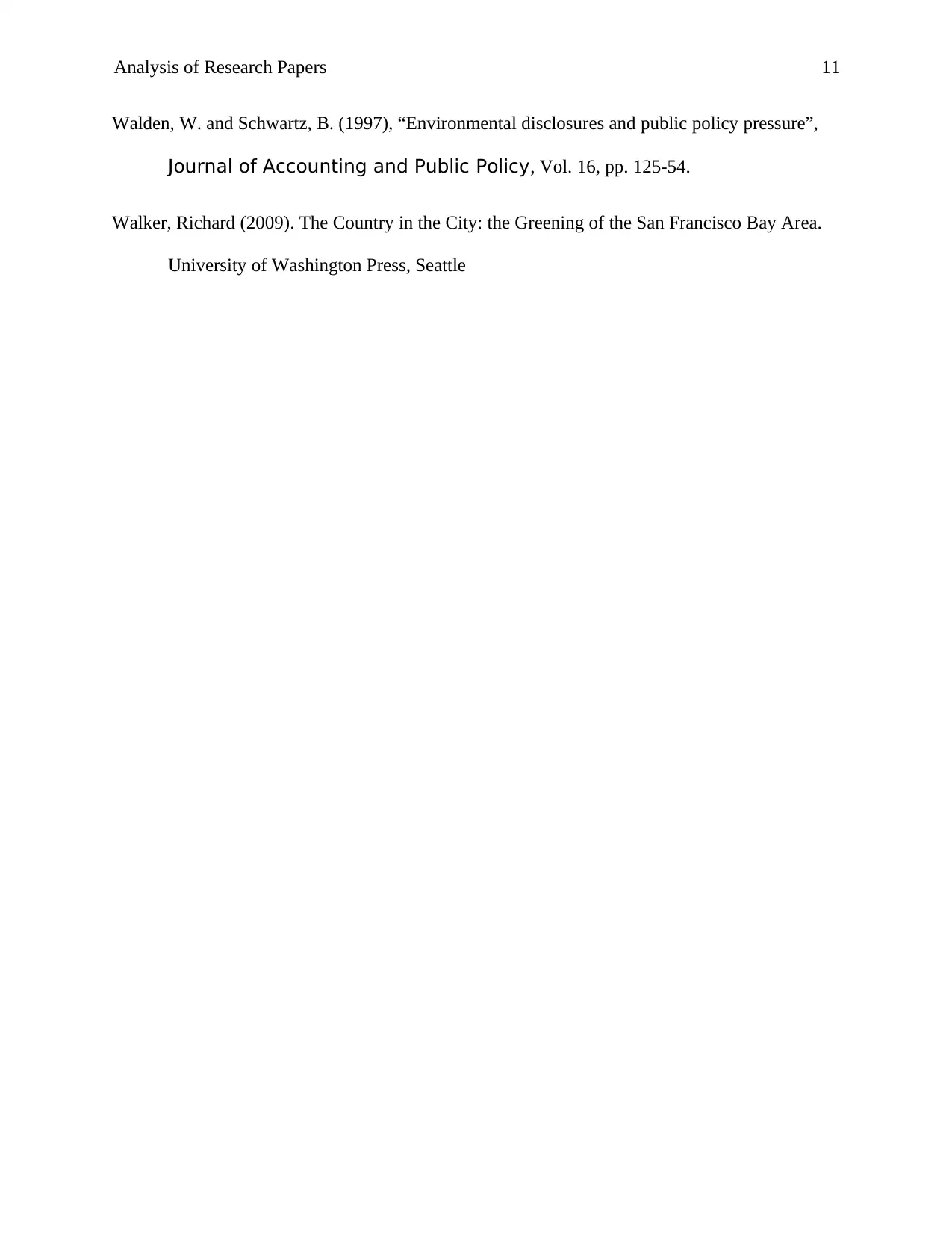
Analysis of Research Papers 11
Walden, W. and Schwartz, B. (1997), “Environmental disclosures and public policy pressure”,
Journal of Accounting and Public Policy, Vol. 16, pp. 125-54.
Walker, Richard (2009). The Country in the City: the Greening of the San Francisco Bay Area.
University of Washington Press, Seattle
Walden, W. and Schwartz, B. (1997), “Environmental disclosures and public policy pressure”,
Journal of Accounting and Public Policy, Vol. 16, pp. 125-54.
Walker, Richard (2009). The Country in the City: the Greening of the San Francisco Bay Area.
University of Washington Press, Seattle
1 out of 11
Your All-in-One AI-Powered Toolkit for Academic Success.
+13062052269
info@desklib.com
Available 24*7 on WhatsApp / Email
![[object Object]](/_next/static/media/star-bottom.7253800d.svg)
Unlock your academic potential
© 2024 | Zucol Services PVT LTD | All rights reserved.

